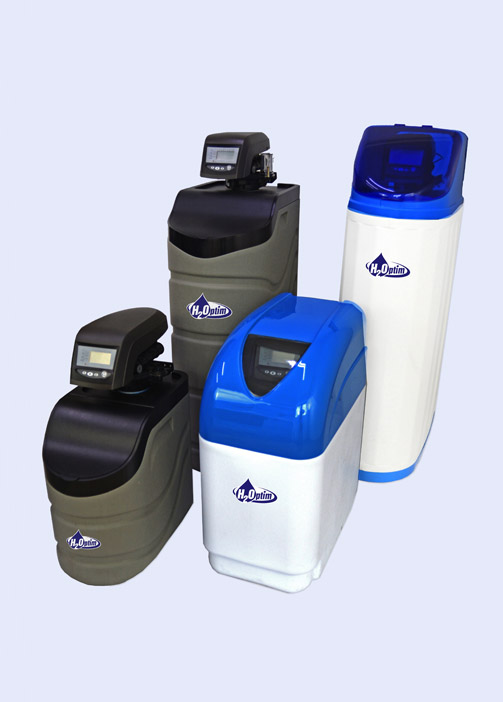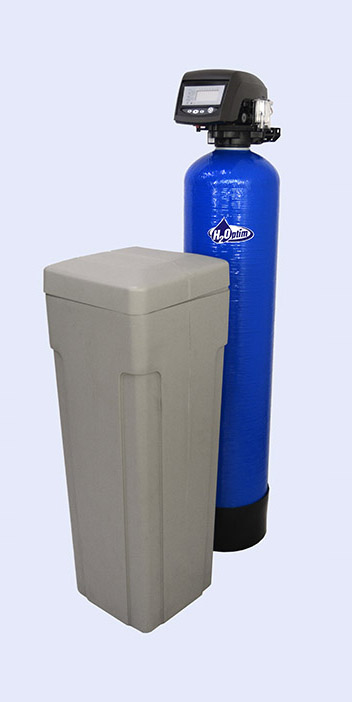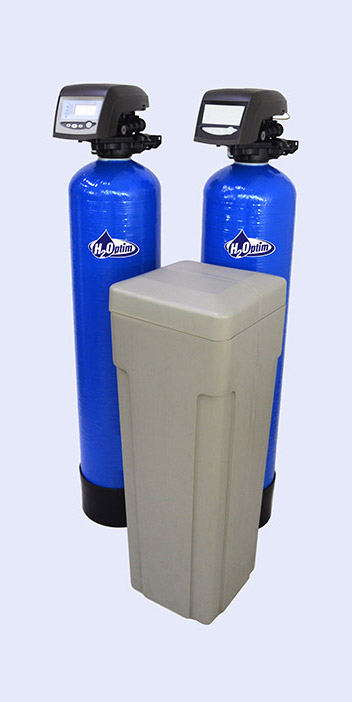Multi devices are innovative as they allow to remove both calcium and magnesium ions (water softening) and iron and manganese ions (iron and manganese removal), as well as ammonia and other organic substances. These filters have extremely low operating costs. They are available both in cabinets and in two-element versions.
The devices are available in a time clock (C) or a flow meter (O) version.
A flow meter (volumetric) version – with a measurement of water consumption – regenerations take place according to the actual water intake with reserve up to a specified regeneration time. In terms of operating costs, it is a more economical and recommended version of water softeners.
Functions of a head in a flow meter version of a softener:
- memory backup;
- cycle length adjustment;
- instantaneous flow indication;
- an indication of the amount of water remaining until the next regeneration.
A time clock version – without a measurement of water consumption – regenerations take place at a set time, regardless of water consumption
Compact devides Single-tank devices Twin-tank devices
Compact devices
A compact device consisting of an fiberglass tank placed inside a plastic brine tank (cabinet) and American control valves, which carry out media regeneration cycles automatically.

|
MODEL |
Ion capacity [oF x m3] |
Salt consumption(1) [kg/1reg.] |
Nominal flow rate [m3/h] |
Maximal flow rate [m3/h] |
Pressure drop (2) [bar] |
|
MULTI OPTIM 13 |
1,0 – 3,0 |
0,3 |
0,4 |
0,1 |
12,5 |
|
MULTI OPTIM 20 |
2,0 – 5,0 |
0,6 |
0,8 |
0,2 |
25 |
(1) Depends on used ion capacity
(2) At nominal flow rate
Single-tank devices
A single-tank device consisting of an fiberglass tank and a separate plastic brine tank and American control valve that carries out media regeneration cycles automatically, using a salt dose from 0.5 to 1kg/m3 of water.
The regeneration of media, in this type of device, may take up to several hours which forces a pause in the softened water supply into the circulation.

|
MODEL |
Ion capacity [oF x m3] |
Salt consumption(1) [kg/1reg.] |
Nominal flow rate [m3/h] |
Maximal flow rate [m3/h] |
Pressure drop (2) [bar] |
|
MULTI OPTIM 12 |
1,0 – 3,0 |
0,3 |
0,4 |
0,1 |
12,5 |
|
MULTI OPTIM 25 |
2,0 – 5,5 |
0,6 |
0,8 |
0,2 |
25 |
|
MULTI OPTIM 40 |
3,0-8,0 |
0,9 |
1,1 |
0,4 |
37,5 |
|
MULTI OPTIM 50 |
4,0-10,3 |
1,3 |
1,5 |
0,6 |
50 |
|
MULTI OPTIM 60 |
5,0-13,5 |
1,6 |
1,9 |
0,7 |
62,5 |
|
MULTI OPTIM 75 |
6,0-16,5 |
1,9 |
2,3 |
0,8 |
75 |
|
MULTI OPTIM 90 |
7,0-19,0 |
2,2 |
2,6 |
0,9 |
87,5 |
|
MULTI OPTIM 100 |
8,0-22,0 |
2,5 |
3,0 |
1,0 |
100 |
(1) Depends on used ion capacity
(2) At nominal flow rate
Twin-tank devices
A twin-tank device is made of two epoxy tanks, a plastic brine tank and two American control valves with a flow meter system, which run media regeneration cycles automatically using a salt dose from 0.5 to 1 kg/m3 of water. This type of device may operate in two modes: parallel and alternating.
In case of parallel work, both tanks work simultaneously which allows filtration for higher maximum flows, but at the same time forces a pause in the softened water supply into the circuit. It is caused by media regeneration which may take up to a couple of hours.
The alternating work allows the continuous operation of the device i.e. one tank is filled with media and operating and the other one is in a regenerating cycle at that time.

|
MODEL |
Ion capacity [oF x m3] |
Salt consumption(1) [kg/1reg.] |
Nominal flow rate [m3/h] |
Maximal flow rate [m3/h] |
Pressure drop (2) [bar] |
|
DUO MULTI OPTIM 12 |
1,0 – 3,0 |
0,6 |
0,8 (1,6)* |
0,1 |
12,5 |
|
DUO MULTI OPTIM 25 |
2,0 – 5,5 |
0,9 |
1,1 (2,2)* |
0,2 |
25 |
|
DUO MULTI OPTIM 40 |
3,0-8,0 |
1,3 |
1,5 (3,0)* |
0,4 |
37,5 |
|
DUO MULTI OPTIM 50 |
4,0-10,3 |
1,6 |
1,9 (3,8)* |
0,6 |
50 |
|
DUO MULTI OPTIM 60 |
5,0-13,5 |
1,9 |
2,3 (4,6)* |
0,7 |
62,5 |
|
DUO MULTI OPTIM 75 |
6,0-16,5 |
2,2 |
2,6 (5,2)* |
0,8 |
75 |
|
DUO MULTI OPTIM 90 |
7,0-19,0 |
2,5 |
3,0 (6,0)* |
0,9 |
87,5 |
|
DUO MULTI OPTIM 100 |
8,0-22,0 |
0,6 |
0,8 (1,6)* |
1,0 |
100 |
(1) Depends on used ion capacity
(2) At nominal flow rate
(*) Aside from regeneration when both column are in service (Twin Parralel version only).

